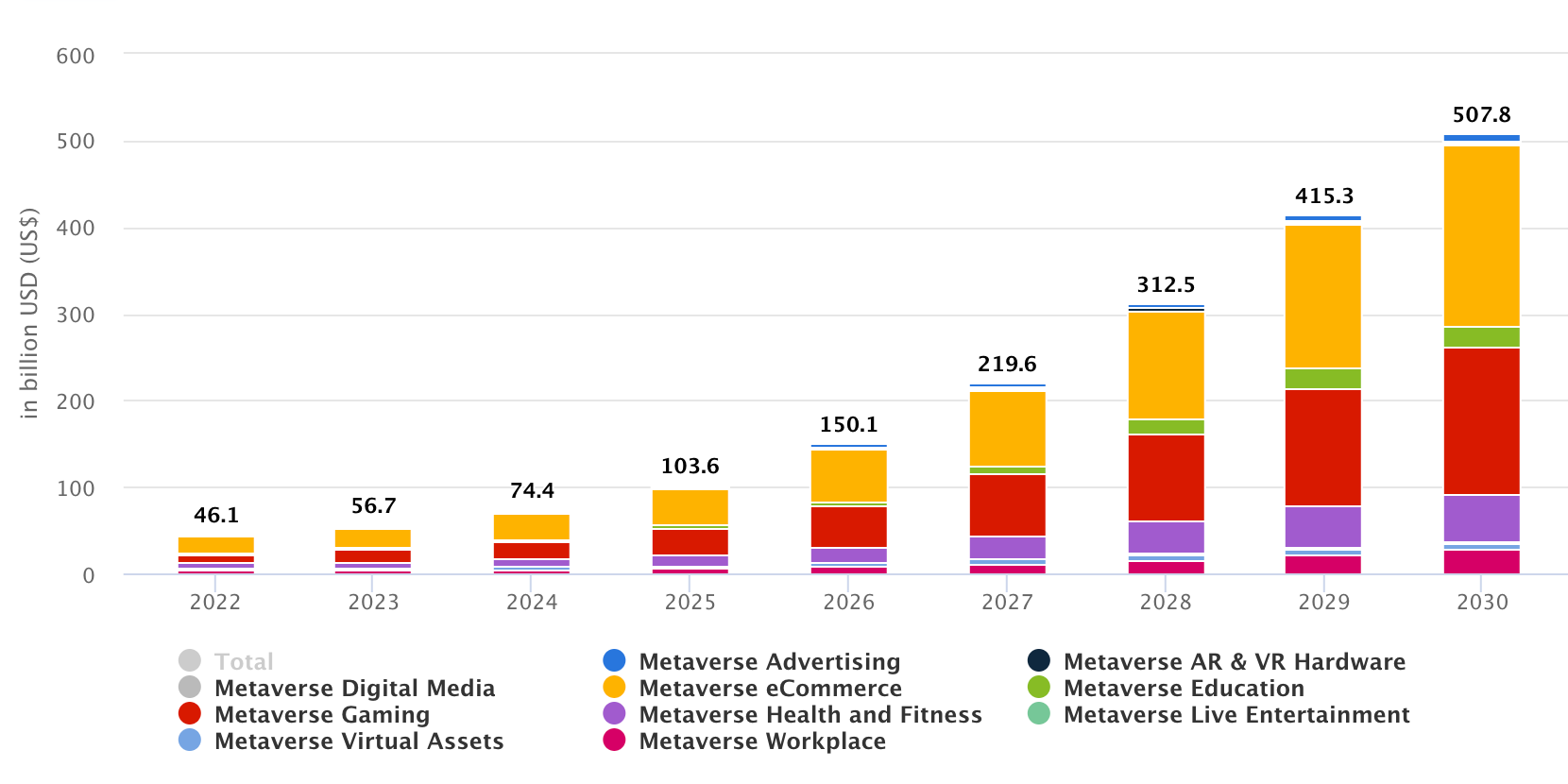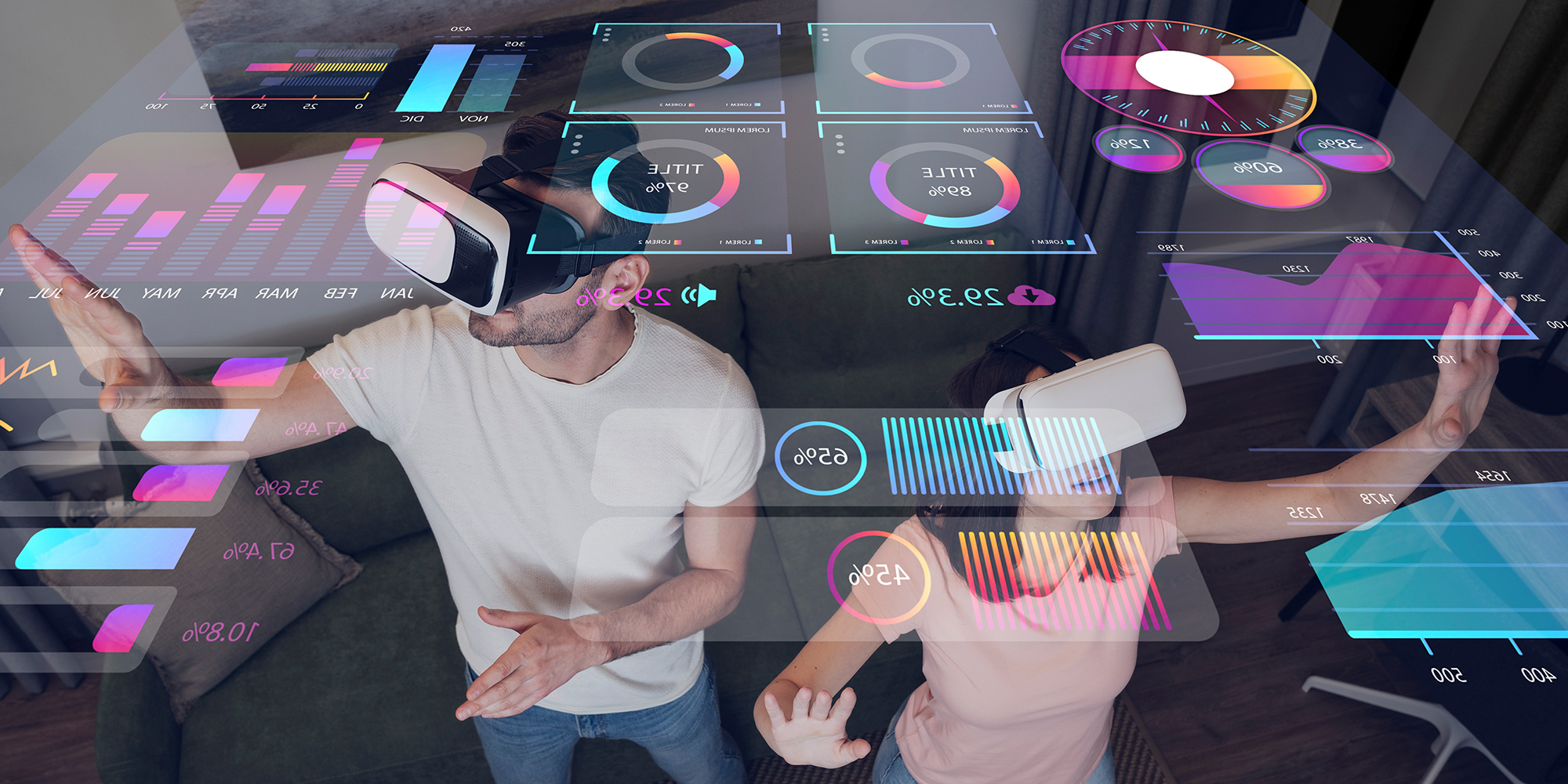Navigating the intricate costs associated with developing a metaverse can be a daunting task. With the evolution of metaverse development services, understanding the financial implications is crucial for anyone looking to venture into this innovative digital space. This introduction aims to shed light on the various factors influencing the metaverse cost.
By examining critical components like technology, design, and scalability, we will uncover strategies for cost-effective solutions in metaverse development. The goal is not only to present an overview of expenses but also to guide enthusiasts and developers in making informed decisions that align with their budget and vision for a metaverse project.
Stay tuned as we explore the financial landscape of the metaverse, offering practical advice and insights to help you manage your investment wisely.
The Business Case for Investing in the Metaverse
In today's digital era, the metaverse is more than a buzzword; it's a burgeoning opportunity for growth and innovation. Metaverse development companies are at the forefront of this revolution, offering businesses a unique chance to redefine their operations, engage with customers, and create new revenue streams in a fully immersive digital environment.
Metaverse market size

The Future and Potential of Virtual Spaces
Virtual spaces, transcending traditional boundaries, rapidly reshape how we interact, work, and play. Propelled by advanced technologies, these digital environments offer a glimpse into a future where virtual and physical realities coalesce seamlessly. As we venture deeper into this era, the potential of virtual spaces in sectors like education, healthcare, and entertainment becomes increasingly apparent.
Once confined to physical classrooms, education finds a new dimension in virtual spaces. Here, interactive and immersive learning experiences break geographical barriers, allowing students from around the globe to engage in a more dynamic and personalized educational journey. Similarly, virtual spaces are revolutionizing patient care and medical training in healthcare. They enable remote consultations and advanced simulations, providing a safe environment for training medical professionals without risking patient safety.
The entertainment industry, already a pioneer in virtual space utilization, continues to innovate. These spaces redefine entertainment, from concerts to virtual theme parks, offering unparalleled experiences that blend creativity with technology. Moreover, virtual spaces are becoming essential in the corporate world. Remote work, enhanced by these spaces, allows for collaborative and interactive meetings, transcending the limitations of physical office spaces. As businesses adapt, virtual spaces become integral in maintaining team dynamics and productivity in a distributed workforce.
Looking ahead, integrating AI and AR/VR technologies will further enhance the capabilities of virtual spaces, making them more intuitive and interactive. This evolution will improve existing applications and unveil new possibilities, cementing the role of virtual spaces as a cornerstone of future technological advancements and societal shifts.
Profitability and Return on Investment in Virtual Realms
Exploring profitability and return on investment in virtual realms hinges critically on understanding the cost of metaverse development and its subsequent management. These digital universes offer businesses unique opportunities to tap into new markets, create innovative revenue streams, and engage with consumers in unprecedented ways.
For retail and e-commerce, virtual realms open doors to virtual storefronts where users can interact with products in a 3D space, enhancing customer experience and boosting sales. Real estate in the metaverse presents another lucrative avenue, where virtual land can be bought, developed, and traded, often at a fraction of the cost of physical real estate, yet with substantial returns as these spaces grow in popularity.
Advertising in the metaverse also introduces a new dimension of marketing, allowing brands to create immersive and interactive ad experiences. This increases engagement and provides a novel way to reach target demographics, especially the tech-savvy and younger generations.
Furthermore, the metaverse's role in events and entertainment, from virtual concerts to conferences, creates revenue streams through ticket sales, sponsorships, and virtual merchandise. Often more cost-effective than their physical counterparts, these events can draw global audiences, amplifying profitability.
In sum, while the initial cost of metaverse entry and development may be significant, the potential for ROI is considerable. This is especially true as the technology matures and more users flock to these virtual spaces, creating a bustling economy with diverse opportunities for revenue generation.
Key Elements Influencing Metaverse Development Cost
Understanding the factors that influence the cost of metaverse development is critical for firms looking to enter this creative digital arena. These elements include everything from technology infrastructure to content development and user experience design, all of which play an essential part in molding the entire investment and its effectiveness in the expanding metaverse ecosystem.
Scope and Intricacy of Virtual Environments
- Scope. Expansive digital landscapes form the backbone of virtual environments, serving as hubs for interaction, innovation, and virtual exploration.
- Intricacy. These environments showcase complex designs, integrating advanced technologies to create realistic and engaging user experiences.
- Customization. Personalization is a hallmark, with options for users to tailor their experiences, from avatars to environmental settings.
- Interactivity. Virtual environments thrive on user interaction, enabling manipulation of elements and dynamic communication within the virtual space.
- Integration. Incorporating VR, AR, and AI, these environments offer enriched, responsive experiences that adapt to user actions and preferences.
Features for Personalization and Interaction
- Custom avatars. Users can create and customize their avatars, allowing for a unique identity in the virtual space.
- Environmental settings. Personalization extends to ecological controls, enabling users to adjust settings like lighting, sound, and landscape.
- Interactive objects. Virtual environments are filled with objects that users can interact with, enhancing the sense of realism and engagement.
- Communication tools. Features like chat, voice, and gesture controls facilitate rich user interaction.
- Personal spaces. Users can design and modify their own virtual spaces, such as homes or meeting areas, for a more personalized experience.
- Social features. Integration of social media elements, like friend lists and sharing options, promotes community building and interaction.
- Dynamic content. Environments often include dynamic content that users can explore and interact with, keeping the experience fresh and engaging.
Synchronizing with Present Systems and Digital Platforms
- API integration. Seamless integration with existing APIs allows for synchronizing data and functions between the metaverse and current digital platforms.
- Single sign-on. Single sign-on (SSO) solutions enable users to access the metaverse using their existing credentials, simplifying entry and enhancing security.
- Data synchronization. Regular data syncing ensures that information remains consistent and up-to-date across the metaverse and other digital systems.
- Cross-platform compatibility. Ensuring metaverse platforms are compatible with various operating systems and devices broadens accessibility and user reach.
- Legacy system integration. Connecting with legacy systems allows for incorporating established processes and data into the metaverse environment.
- Cloud integration. Leveraging cloud technologies facilitates scalable and efficient data storage and computing power, which is essential for expansive virtual environments.
- Social media connectivity. Integrating social media platforms enhances user engagement and promotes content sharing across digital spaces.
Obstacles in Predicting the Costs of Metaverse Creation
Accurate cost prediction for metaverse creation poses a significant challenge. The dynamic and rapidly evolving nature of this digital domain, influenced by ever-changing technological advancements and market dynamics, complicates the process of estimating both initial investments and ongoing operational expenses.
The Rapid Pace of Technological Advancement
The metaverse, driven by swift technological advancements, presents a dynamic and evolving digital frontier. This rapid progression is pivotal for metaverse consulting as it navigates through several key developments:
- Emerging technologies. Innovations in VR, AR, and AI are continually reshaping user experiences and functionalities in the metaverse.
- Faster computing power. Increased processing capabilities enable more complex and intricate virtual environments.
- Enhanced connectivity. Improvements in internet speed and reliability facilitate more stable and immersive experiences.
- Software development. Ongoing updates and new tools allow for sophisticated design and interaction within virtual spaces.
- User interface innovations. Advances in UI/UX design lead to more intuitive and engaging user interactions.
- Security measures. As the metaverse grows, robust security protocols become essential to protect users and data.
In this highly competitive industry, metaverse consulting is crucial, offering guidance and expertise to businesses and individuals aiming to harness the latest technologies for effective engagement and growth in the metaverse.
The Absence of Uniform Frameworks for Development
The absence of uniform frameworks in metaverse development presents a unique set of challenges and opportunities. Diverse approaches mark this issue:
- Varied standards. Without universal guidelines, developers employ various standards, leading to a wide range of user experiences.
- Innovative freedom. Creativity flourishes as developers are not confined to strict protocols, encouraging innovative solutions.
- Interoperability issues. The lack of standardization can lead to compatibility challenges across different metaverse platforms.
- Custom solutions. Developers often create bespoke solutions tailored to specific project needs.
- Regulatory uncertainty. The absence of standardized regulations necessitates a cautious approach to legal and ethical considerations.
- Collaborative potential. This environment encourages collaboration and knowledge sharing among developers to establish best practices.
Steering this unstandardized terrain requires adaptability and strategic foresight, highlighting the importance of experienced guidance in metaverse development projects.
Fluctuating Market Trends and Consumer Preferences
In metaverse development, fluctuating market trends and consumer preferences play a crucial role, marked by several factors:
- Consumer interests shift. The changing tastes and preferences of users necessitate agile adaptation from developers.
- Market volatility. The metaverse market undergoes rapid changes due to technological advances and global economic factors.
- User feedback is key. Consumer opinions and feedback significantly shape metaverse experiences.
- Diverse demographics. Addressing a wide range of user groups requires versatile design approaches.
- Competitive dynamics. New technologies and entrants into the market drive innovation and competitiveness.
- Cultural trends influence. The impact of global cultural trends on user engagement and content relevance varies across regions.
These factors highlight the importance for developers and businesses in the metaverse to stay responsive and adaptive to current market and consumer dynamics.
Required Technological Framework for Metaverse Creation
A comprehensive technological framework is essential for metaverse creation. This foundation combines advanced technologies to enable immersive user experiences, efficient content creation, and seamless operation within expansive digital environments.
Critical Software and Technological Tools
Using open-source 3D modeling tools can help you save money without sacrificing the quality of your digital environment. Game engines, essential for bringing the metaverse to life, vary significantly in price and feature set. Popular engines, such as Unity or Unreal Engine, offer free versions for smaller projects, while commercial versions offer greater features for larger, more complicated worlds. Another crucial consideration is server infrastructure.
Cloud-based solutions, such as AWS or Azure, offer scalable and adaptable options, with charges directly related to consumption, assuring effective resource allocation. Effective networking solutions are critical for user experience; costs vary, and choosing one that gives the required performance at a reasonable price is critical. These elements must be balanced in order to create a cost-effective yet technologically robust metaverse.
Necessities in Hardware and Infrastructure
High-performance servers are essential for a metaverse to run smoothly. They ensure scalability and smooth operation while managing complex computations and big user bases. Furthermore, effective data storage solutions are required. Options range from local data centers to cloud-based services, each with its own set of costs. In order to provide real-time interactions and data transfers, the network infrastructure must be of the highest caliber, supporting high-speed internet connections.
The role of graphics processing units (GPUs) in rendering the virtual environment is critical. Investing in high-performance GPUs allows for more detailed and immersive experiences. A complete immersive experience requires user-accessible and advanced virtual reality and augmented reality gear. This comprises headsets, motion trackers, and haptic feedback devices, the prices and quality of which vary considerably.
Finally, energy-efficient technologies are critical for long-term operations, as they reduce long-term expenses and environmental effects. Building a viable and accessible metaverse requires balancing these hardware and infrastructure components.
How Much Does it Cost to Develop Metaverse for Various Industries?
Exploring the cost of developing a metaverse across different industries reveals a diverse financial landscape. Each sector, from gaming to education, faces unique challenges and opportunities. This exploration uncovers the varied investments needed to create immersive virtual worlds tailored to specific industry needs and audience engagement strategies.
Costs in the Gaming and Entertainment Sector

In the gaming and entertainment sector, understanding how much does the metaverse cost involves considering several factors:
- Development. High-quality game design and world-building are costly, including paying for skilled developers and artists.
- Technology. Advanced VR and AR technologies are essential. Investing in cutting-edge hardware and software boosts user experience.
- Marketing. Effective promotion drives user engagement. Costs include advertising and community-building strategies.
- Maintenance. Ongoing server costs and updates are necessary to ensure the metaverse remains operational and up-to-date.
- Licensing. Intellectual property rights can be significant. This includes costs for music, characters, or branded content.
Expenditure in Educational and Training Fields

In the educational and training fields, assessing the metaverse development cost involves several essential expenditures:
- Content creation. Developing educational content tailored for the metaverse requires investment in specialized developers and instructional designers.
- Platform customization. Adapting metaverse platforms to suit educational needs can incur significant costs.
- Hardware provision. Distributing VR headsets and other necessary devices to learners adds to the overall expense.
- Software licenses. Acquiring and maintaining educational software within the metaverse can be costly.
- Training and support. Ensuring educators and students are proficient in using these technologies requires ongoing training and support services.
Investment in Retail and Online Commerce

In retail and online commerce, the investment in metaverse development involves diverse costs:
- Virtual store design. Creating immersive and interactive shopping environments demands investment in 3D modeling and design expertise.
- Payment integration. Incorporating secure and efficient payment gateways is essential, adding to the development cost.
- Customer engagement tools. Investing in interactive features like AI chatbots and virtual assistants enhances the shopping experience.
- Marketing campaigns. Innovative marketing strategies within the metaverse require budget allocation for maximum impact.
- Data analytics. Implementing advanced analytics tools to track customer behavior and preferences is crucial for tailored marketing and inventory management.
Comparative Analysis of Metaverse Development Costs by Country
The cost of developing metaverse enterprise solutions varies greatly depending on the country. This comparative study dives into the financial ramifications of various places. Factors such as labor costs, technology infrastructure, and market dynamics all play an important part in determining the worldwide investment landscape for metaverse enterprises.
International Cost Comparison for Metaverse Development
In examining the cost dynamics for developing metaverse enterprise systems globally, stark contrasts emerge. In technologically advanced nations like the United States and Japan, the blend of high labor costs and sophisticated technological demands escalates expenses. Often at the forefront of innovative features, these regions command a premium for their advanced infrastructural capabilities. Conversely, emerging tech hubs like India and Brazil offer more economical development options. Lower labor costs in these countries can translate to reduced overall expenditures, though this occasionally comes with trade-offs in technological refinement or access to state-of-the-art resources.
The situation within the European Union presents a diverse scenario. Despite having labor costs on par with the United States, Germany and the United Kingdom benefit from significant government support in technological innovation, which might counterbalance the higher expenses. Meanwhile, Eastern European countries are emerging as cost-effective alternatives for quality development, propelled by factors like tax incentives, government funding, and local talent.
Regional Factors Influencing Metaverse Development Costs
The development costs for metaverse solutions are intricately linked to regional characteristics. Higher wages for skilled tech professionals in regions like the United States and Western Europe contribute to elevated development costs. On the other hand, Southeast Asia, known for more affordable labor, presents a contrasting picture by reducing overall development expenses.
Access to technology and infrastructure is another critical element. North America and certain Asian territories, with their well-established technological ecosystems, offer superior tools and services, albeit at a higher cost. Areas with developing tech infrastructures may face additional costs associated with importing technology or limitations in achievable technological feats.
Governmental policies and incentives also play a significant role. Countries offering tax reliefs, grants, or subsidies for tech development become attractive locales for metaverse projects. For example, certain European and East Asian countries foster innovation through supportive policies, thereby lessening the financial strain on developers.
Lastly, the economic status of the target market influences pricing strategies. In wealthier regions, developers might allocate more resources to advanced features, aiming for a higher return on investment. In contrast, affordability is prioritized in less affluent areas to ensure wider accessibility. These regional variances critically shape the economic landscape of metaverse development, influencing strategies from the planning phase to execution.

Case Studies of Successful Metaverse Implementations and Their Costs
The complexities of effective metaverse implementations across many sectors are revealed through a series of case studies. Each story thoroughly describes the expenses and tactics involved, exposing the financial and technical aspects required for creating these complex virtual environments in a variety of sectors.
Examining Leading Metaverse Initiatives
Examining leading Metaverse initiatives reveals a diverse range of platforms, each catering to unique aspects of virtual world experiences:
MetaOffice. Program-Ace introduced MetaOffice, a metaverse combining work and immersion. Ideal for PC and VR, it offers versatile spaces for presentations, meetings, and relaxation. Features include avatar control, video and chat windows, animated environments, and a capacity for 32 users. An AI assistant guide powered by ChatGPT is in development to enhance user interaction and experience.
Roblox. A massive online platform for game development and playing, Roblox boasts over 56m daily active users. It allows users to create and sell virtual items and games using a virtual currency called Robux for transactions. The platform also features a diverse array of user-generated games across multiple genres, offering a unique platform for creativity.
Sandbox Metaverse. This decentralized gaming platform lets users create, share, and monetize gaming experiences using blockchain technology. Though it doesn't support VR, it offers a glimpse into potential VR experiences. The platform empowers creators with tools for building intricate gaming worlds, fostering a community of game developers and players.
Decentraland. Utilizing blockchain, Decentraland is a virtual reality platform where users can create, enjoy, and monetize content and applications. It offers unique LANDs for purchase and development, along with SDKs for content creation. Players can also design customized NFTs, enhancing the platform's interactivity and creativity.
Horizon Worlds. Created by Meta (formerly Facebook), this platform allows users to play games, interact, and host virtual events. The Meta Quest and Oculus Quest 2 headsets offer an immersive experience for accessing Horizon Worlds. It features user-created spaces and a central plaza linking diverse virtual worlds, enhancing social connectivity and creativity.
Each of these platforms showcases the varied applications and potential of metaverse technology, from real estate to gaming and social interactions.
Elevate Your Events: Metaverse Concert Platform by Program-Ace

Embark on a journey with our groundbreaking Metaverse Event Design and Organizing Platform, transforming event landscapes. Experience a fusion of traditional and digital ticketing, immersive environments powered by Unreal Engine 5, and innovative NFT merchandise interactions.
Summing Up the Prices
In the metaverse industry, the cost of developing various platforms spans a broad range. Here are the details:
| Metaverse Development Cost |
| 1. Developing an E-commerce Platform can cost between $25,000 and $400,000. |
| 2. Creating a Social Media Platform ranges from $25,000 to $400,000 in development costs. |
| 3. For an Event Organization Platform, the development cost lies between $35,000 and $350,000. |
| 4. Setting up an NFT Marketplace requires an investment ranging from $50,000 to $500,000. |
| 5. A Gaming Platform's development can cost between $30,000 and $300,000. |
| 6. Implementing Virtual Office Solutions might range from $25,000 to $350,000 in terms of cost. |
| 7. The Fashion Industry Metaverse platform development costs between $30,000 and $250,000. |
| 8. A Banking/Finance Platform in the Metaverse may cost between $50,000 and $500,000 to develop. |
| 9. Developing a Real Estate Platform could require an investment ranging from $35,000 to $300,000. |
| 10. For Healthcare Services in the Metaverse, development costs range from $30,000 to $300,000. |
These figures indicate a diverse investment landscape, reflecting the varied nature of metaverse platform development. However, these are rough estimations. So if you want a more precise and tailored approach, feel free to contact our experts for a professional consultation regarding your own project.
The Unique Offerings of Program-Ace in Metaverse Development
Program-Ace, a software development company, excels in metaverse development. We specialize in creating customized virtual environments for diverse industries, offering immersive experiences with custom avatars and real-time interactions. Our utilization of advanced technologies and AR/VR ensures cutting-edge solutions.
If you are ready to embark on your metaverse journey or elevate your existing virtual space, don't hesitate to contact us. We are here to transform your vision into a metaverse reality.






















